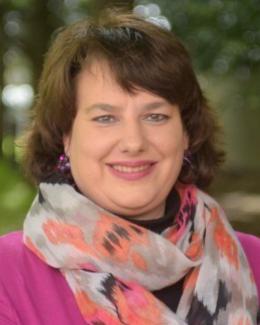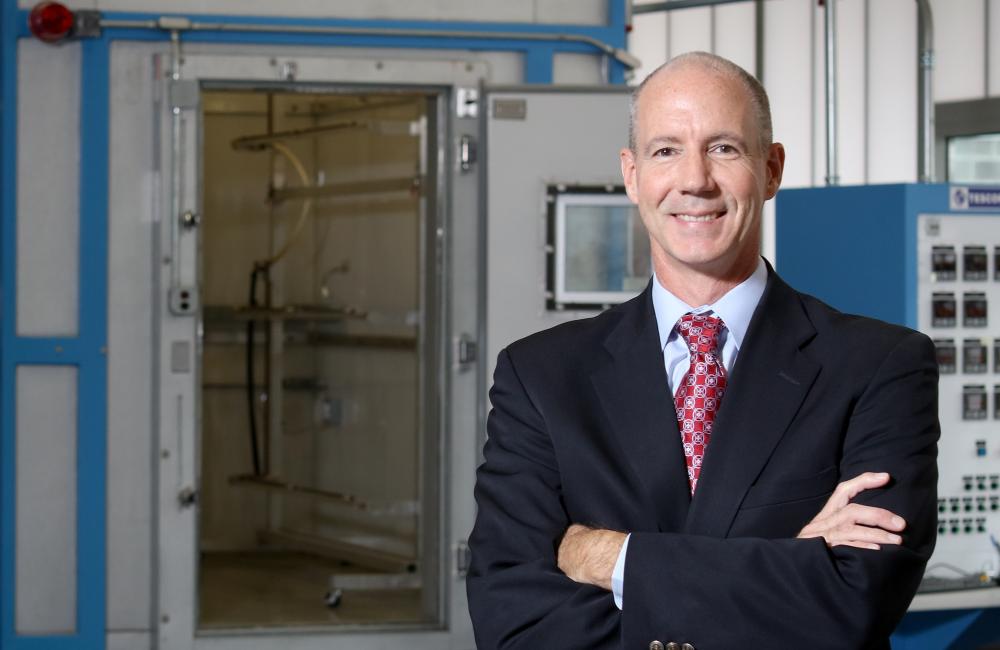A curious mind can go far at Oak Ridge National Laboratory, as Ron Ott has learned over the course of a career ranging from materials research to organizational leadership. He now brings that deep well of technical expertise and collaborative thinking to his new role as manager of the Building Technologies Program at ORNL.
Ott’s journey began more than 20 years ago when he came to ORNL to conduct doctoral research after earning a master’s degree in materials engineering from the University of Alabama at Birmingham.
“I spent three years, from 1994-1997, in the High Temperature Materials Laboratory [HTML],” Ott said. “I studied the wear and tear of materials, looking at the mechanical properties of ceramics at high temperatures. At ORNL, I learned that you have the ability to do whatever you want to do as long as you have curiosity and can find the funding.”
Ott’s doctoral work in materials research led to a full-time staff engineer position with ORNL in surface processing, mechanics, and materials processing, beginning in the tribology user center at HTML where he pioneered a unique Pulse Thermal Processing technology for thin-film and nanoparticle flexible electronics.
As a staff researcher, Ott’s expertise in materials continued to gain notice, eventually enabling a move from technical work to management and operations. Since 2011, Ott has served as the deputy director of the Energy and Transportation Science Division (ETSD). He’s also managed ORNL’s Remote Research Campus since 2014 and led research efforts for two years at the Carbon Fiber Technology Facility.
“While serving as deputy division director, I had success in trying to tie all the programs within the [Department of Energy’s] Energy Efficiency and Renewable Energy (EERE) program together, breaking down the borders between transportation, buildings and manufacturing,” Ott said. “I focused on operations, working with the designated user facilities within the ETSD space. But I really wanted to return to the technical field, and with my new role in the Building Technologies Program, I can jump back in. I started in technology here; this move just allows me to come full circle.”
It’s this history with ORNL that Ott anticipates will help him work quickly, identifying new ways to create synergy between the EERE programs. “I came up in this lab and I know how it operates. I understand how EERE works too,” he said. “I can hit the ground running, expanding Building Technologies Program opportunities.”
Some of those opportunities include what Ott calls the next big thing: gas-fired appliances.
“I think immediately we’re going to look at how we go beyond vapor compression, understanding the challenges. We have the ability to tap into those resources that we already have expertise in—like combustion and modeling, capturing and filtering carbon dioxide, and separations capabilities,” he said. “Working with the Materials Science and Technology and Chemical Sciences Divisions, we can continue to bring depth to that field.”
Advice to young scientists: Seek out collaborators in multiple disciplines
Overlapping projects across divisions is all part of what Ott sees as a continued focus on synergy between programs. “On the combustion side of the house, for example at the National Transportation Research Center, we have staff who have worked in the modeling and combustion space for decades. These individuals can bring expertise to buildings projects immediately as far as trying to understand different pathways for refrigeration, cooling and heating,” he said.
With EERE’s shift in focus to more early stage scientific research, Ott anticipates that knowledge in materials will be crucial.
“ORNL is renowned for materials research,” he said. “We have the opportunity to really stand out in the crowd and bring some uniqueness to that space. A lot of things we are doing in the composites and carbon fiber space, looking at what we’re doing in precast for example—there’s really an opportunity to do more of this type of work. And on the chemical side, with our work in phase change materials, we can use resources that no other lab has but ORNL. “
It’s this forward momentum that Ott plans to champion. “I want to be able to expand and reach out beyond the traditional building environment and work with the resources we have in manufacturing, for example,” he said. “We have tremendous opportunity in transactive controls and cybersecurity and this doesn’t just impact buildings. It impacts manufacturing, transportation, grid. Many sponsors have interest in this space and we can expand the program beyond its borders, tying together and leveraging with other sponsors to bring to bear our unique capabilities.”
Looking back on his career path at ORNL, Ott sees clearly now how the knowledge he gained as a young researcher has proven invaluable to his current and future plans.
“I have seen a big shift from the single principal investigator projects—expanding to the much- larger project with more researchers and staff, across different disciplines and largely driven by sponsors,” he said. “I would tell any early career researcher to make sure you engage other staff and researchers inside and outside your discipline. Don’t be isolated in your research; expand your world beyond your area.”
Ott’s pattern of being able to look past the here and now and into the future extends not just to his professional life but also his personal life.
“Everybody in my family went into the medical field but me,” he said. “Growing up, I loved cars and tinkering. My Dad always had something he was working on. I remember holding the flashlight for him as a kid, wanting to look inside that car and understand how it works. Cars and racing got me into engineering; I love the dynamics of the sport.”
When Ott isn’t at ORNL, he and his wife enjoy time on and off the tennis court with their two teenage sons—ages 17 and 16. The oldest will head to college soon to pursue a major in biology and chemistry, carrying on the family tradition of pursuing a science career.
ORNL is managed by UT-Battelle for the Department of Energy's Office of Science, the single largest supporter of basic research in the physical sciences in the United States. DOE’s Office of Science is working to address some of the most pressing challenges of our time. For more information, please visit http://energy.gov/science.



